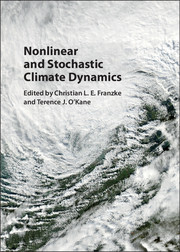Book contents
- Frontmatter
- Contents
- List of Figures
- List of Contributors
- Preface
- 1 Challenges for Ice Age Dynamics: A Dynamical Systems Perspective
- 2 Tipping Points in the Climate System
- 3 Atmospheric Teleconnection Patterns
- 4 Atmospheric Regimes: The Link between Weather and the Large-Scale Circulation
- 5 Low-Frequency Regime Transitions and Predictability of Regimes in a Barotropic Model
- 6 Complex Network Techniques for Climatological Data Analysis
- 7 On Inference and Validation of Causality Relations in Climate Teleconnections
- 8 Stochastic Climate Theory
- 9 Stochastic Subgrid Modelling for Geophysical and Three-Dimensional Turbulence
- 10 Model Error in Data Assimilation
- 11 Long-Term Memory in Climate: Detection, Extreme Events, and Significance of Trends
- 12 Fractional Stochastic Models for Heavy Tailed, and Long-Range Dependent, Fluctuations in Physical Systems
- 13 Modelling Spatial Extremes Using Max-Stable Processes
- 14 Extreme Value Analysis in Dynamical Systems: Two Case Studies
- Index
4 - Atmospheric Regimes: The Link between Weather and the Large-Scale Circulation
Published online by Cambridge University Press: 26 January 2017
- Frontmatter
- Contents
- List of Figures
- List of Contributors
- Preface
- 1 Challenges for Ice Age Dynamics: A Dynamical Systems Perspective
- 2 Tipping Points in the Climate System
- 3 Atmospheric Teleconnection Patterns
- 4 Atmospheric Regimes: The Link between Weather and the Large-Scale Circulation
- 5 Low-Frequency Regime Transitions and Predictability of Regimes in a Barotropic Model
- 6 Complex Network Techniques for Climatological Data Analysis
- 7 On Inference and Validation of Causality Relations in Climate Teleconnections
- 8 Stochastic Climate Theory
- 9 Stochastic Subgrid Modelling for Geophysical and Three-Dimensional Turbulence
- 10 Model Error in Data Assimilation
- 11 Long-Term Memory in Climate: Detection, Extreme Events, and Significance of Trends
- 12 Fractional Stochastic Models for Heavy Tailed, and Long-Range Dependent, Fluctuations in Physical Systems
- 13 Modelling Spatial Extremes Using Max-Stable Processes
- 14 Extreme Value Analysis in Dynamical Systems: Two Case Studies
- Index
Summary
Abstract
Recurrent atmospheric flow patterns are those that occur more often than expected by chance, and their identification has been an underlying theme in atmospheric science on time scales ranging from weather forecasting to inter-annual fluctuations. This chapter focuses on identifying recurrent, and also persistent flow patterns on intra-seasonal time scales. Recurrent blocking structures seen in five-day means of the 500 hPa geopotential height (Z500) field motivate the use of a new scalar planetary wave index, whose probability distribution function (pdf) is very non-Gaussian, and hints at bi-modality. The search for maxima in pdfs in higher dimensions is best done in the reduced dimensional coordinates defined by principal component analysis, with pdf density maxima assessed as significant against a multi-dimensional Gaussian null hypothesis.
Using these ideas, we apply the k-means method of cluster analysis to recover wellknown preferred structures (known as weather regimes) occurring in the Euro-Atlantic region on time scales of 10 to 90 days during boreal winter. Synthetic time series of statistically independent principal components are generated to assess statistical confidence of the analysis. We give a detailed discussion of both the generation of the synthetic time series, and the expected signal-to-noise ratio for multi-modal pdfs in higher dimensions. A layered application of cluster analysis to weather forecasts of the European Centre for Medium-Range Weather Forecasts utilizes forecast scenarios (clusters of the 51-member ensemble evolution of Z500 within a short time window) in order to synthesis information about large-scale structures from the ensemble. Verification is done against the previously defined weather regimes.
For application beyond the very robust Euro-Atlantic regimes, more sophisticated tools are needed. The mixture model approach to modeling the full pdf with a multiple Gaussian components is presented. The use of dynamical information (in the form of the time evolution of fields), as well as explicit criteria for persistence, is a feature of the Hidden Markov Method. Using the foundation provided in the earlier sections, readers will be prepared to study these and other statistical/dynamical tools.
- Type
- Chapter
- Information
- Nonlinear and Stochastic Climate Dynamics , pp. 105 - 135Publisher: Cambridge University PressPrint publication year: 2017
- 13
- Cited by

